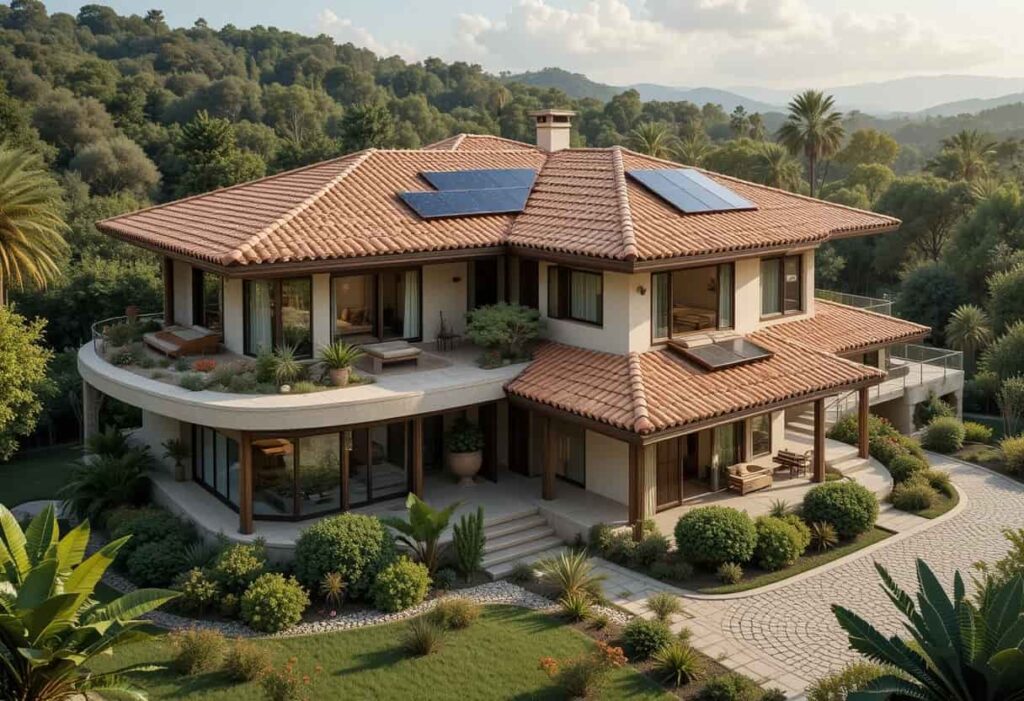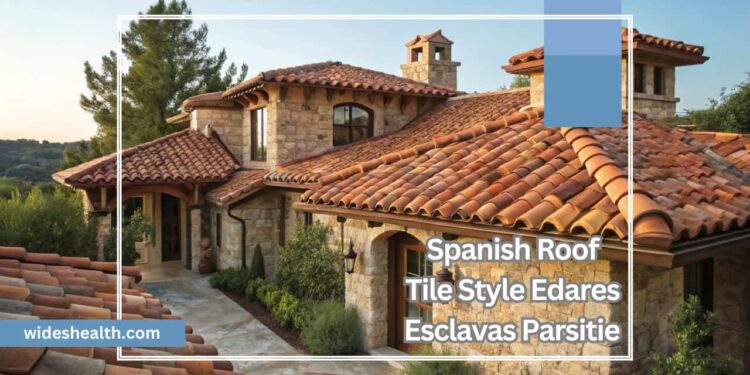When I first started building my dream home, I never thought the roof style would be one of the most difficult choices. I looked at so many options—flat roofs, metal sheets, shingles—but something about the Spanish roof tile style edares esclavas parsitie caught my attention.
At first, I didn’t even understand what this long name meant. But once I saw real-life examples and talked to some roofing experts, I realized this was not just a roofing option—it was an experience. In this article, I want to share my personal story with this unique roof style. If you’re building or renovating a house, this might help you decide if the Spanish roof tile style edares esclavas parsitie is the right fit for you.
What Is Spanish Roof Tile Style Edares Esclavas Parsitie?

Breaking Down the Name:
The term mixes tradition and artistry. “Spanish roof tile style” refers to curved clay tiles often used in Mediterranean homes. “Edares esclavas parsitie” adds a unique touch, describing the special, handcrafted pattern of laying tiles. This method creates a beautiful and luxurious look that adds charm, elegance, and personality to any home.
Inspired by Mediterranean Architecture:
This style is inspired by traditional architecture from places like Spain, Italy, and Greece. The tiles are often S-shaped and made from terracotta or natural clay. They are arranged in a curved pattern, creating a wavy, flowing effect. This design brings warmth, character, and an artistic feel to homes, making them look classic and beautiful.
What Is Spanish Roof Tile Style Edares Esclavas Parsitie?
The Spanish roof tile style edares esclavas parsitie is a roofing design rooted in traditional Spanish architecture. These tiles are known for their curved or flat shapes, typically made from clay or concrete, and come in warm terracotta, red, and beige tones.
The term “edares esclavas parsitie” roughly translates to “enslaved details,” referring to the intricate craftsmanship and cultural motifs embedded in the tiles. This style isn’t just about looks—it’s built to withstand harsh weather while keeping homes naturally insulated.
Key Features:
- Material – Clay or Concrete: These tiles are made from strong materials like clay or concrete, known for lasting many years. Clay gives a more traditional look, while concrete offers added strength. Both materials can handle rough weather, making them a smart and long-term choice for roofing in warm or changing climates.
- Design – Curved or Flat Tiles: The tiles usually come in two shapes: curved barrel tiles or flat mission tiles. Curved tiles create a wave-like pattern on the roof, while flat tiles give a cleaner, straight look. Both styles add charm and personality, and homeowners can choose based on what fits best with their house design.
- Colors – Earthy and Warm Tones: Spanish-style tiles often come in natural, earthy colors like terracotta, sand, rust, and brown. These tones help the roof blend beautifully with the environment. The warm shades not only look attractive but also give the home a cozy, welcoming feel that works well in both city and countryside homes.
- Durability – Withstands Harsh Weather: One of the strongest points of this roofing style is how tough it is. These tiles are made to resist high heat, heavy rain, and strong winds. They don’t wear out quickly and need less repair. That’s why people living in hot or stormy areas prefer this type of roof.
- Low Maintenance – Easy to Care For: Once installed properly, Spanish roof tiles need very little maintenance. They don’t rot, rust, or warp, which means fewer problems over time. Occasional cleaning and inspections are usually enough. Their natural materials and design make them strong, reliable, and a great investment for homeowners who want both style and function.
Why I Chose This Style – My Honest Story?
First Impressions:
The first time I saw this roof on my friend’s villa, I couldn’t stop admiring it. The curved terracotta tiles, along with the earthy tones, gave the house a rustic, timeless elegance. When he told me it was called “Spanish roof tile style edares esclavas parsitie,” I didn’t fully understand, but I instantly knew this was the look I wanted for my own home.
Family Reactions:
After installing the roof, my family was amazed by the transformation. My wife said it instantly reminded her of their vacations in Spain, while the kids thought it made the house look unique and stylish. Neighbors even stopped by to compliment the design. It hit me then—the roof wasn’t just about aesthetics. It added warmth, identity, and character to our home.
Beauty That Speaks for Itself:
Curb Appeal Boost:
When the roof was installed, the transformation was immediate. It gave our home a touch of European elegance, making it feel both cozy and refined. The flowing tile design reflects sunlight, creating a warm, inviting glow. It’s amazing how many people have stopped to compliment the roof and ask about the unique style.
Natural and Warm Colors:
The tiles come in earthy shades like reddish-brown, beige, and sand, blending perfectly with gardens, stone walls, and modern glass. These natural tones strike a perfect balance, not too old-fashioned or too contemporary. They bring a timeless warmth that complements any home design, making the roof feel both elegant and approachable at the same time.
How Spanish Roof Tiles Add Value to Your Home?
Investing in Spanish roof tile style edares esclavas parsitie significantly enhances your property’s value through multiple advantages. The timeless Mediterranean elegance creates instant curb appeal, attracting discerning buyers who appreciate architectural character. Their exceptional durability—often lasting 50+ years—means fewer replacements compared to conventional roofing, offering long-term cost savings.
The tiles’ natural thermal properties regulate indoor temperatures, reducing energy consumption and utility bills year-round. These combined benefits not only increase your home’s marketability but also justify a higher asking price, making them a smart investment that pays dividends in both aesthetics and functionality for decades to come.
The Aesthetic Appeal of Spanish Roof Tiles:
The Spanish roof tile style edares esclavas parsitie captivates with its timeless beauty, blending Mediterranean charm into modern homes. Its warm terracotta hues and textured designs enhance villas, farmhouses, and Spanish Colonial architecture.
Homeowners love its versatility—whether for classic or contemporary styles, these tiles create depth and elegance. The natural tones harmonize with landscapes, making rooftops visually striking yet effortlessly cohesive with any setting.
Why Homeowners Love It?
- Warm, inviting tones: The earthy reds and beiges of Spanish tiles blend perfectly with natural landscapes, creating a welcoming aesthetic that enhances any home’s exterior while maintaining authentic Mediterranean charm.
- Textured patterns: These tiles add striking visual depth through their unique surface variations, delivering rustic elegance that makes rooftops stand out while maintaining timeless architectural appeal.
- Versatile designs: From traditional villas to contemporary homes, these tiles adapt seamlessly to various architectural styles, offering design flexibility without compromising their classic Spanish character.
- Timeless appeal: Unlike trendy materials, Spanish roof tiles never fade in popularity, ensuring long-lasting curb appeal that increases property value for decades.
- Cultural richness: Each tile reflects centuries-old Spanish craftsmanship, infusing homes with authentic heritage and artisanal beauty that mass-produced materials can’t replicate.
Practical Benefits of Edares Esclavas Parsitie Roofing:
Beyond stunning aesthetics, Spanish roof tiles offer exceptional functionality. Their clay composition provides natural heat resistance, keeping interiors cooler in summer. The signature curved design efficiently channels rainwater while resisting high winds. As non-combustible materials, they provide superior fire protection compared to traditional roofing options. These tiles also deliver excellent thermal regulation, reducing energy costs year-round. With proper installation, they can last over 50 years with minimal maintenance required.
Weather Resistance:
Spanish roof tiles excel in extreme weather conditions. Their dense clay material reflects sunlight, preventing heat absorption into the home. The interlocking curved design creates a waterproof barrier that sheds rain effectively. These tiles maintain structural integrity even in hurricane-force winds. Their fireproof qualities make them ideal for wildfire-prone regions. This combination of protective features ensures long-term durability against nature’s elements.
Energy Efficiency:
The thermal mass properties of clay tiles naturally regulate indoor temperatures. In summer, they block heat transfer to keep interiors cool. During winter, they retain warmth to reduce heating needs. This passive temperature control can lower energy bills significantly. Their ventilation-enhancing design promotes air circulation beneath the tiles. These energy-saving qualities make them an eco-friendly roofing choice for climate-conscious homeowners.
Longevity & Maintenance:
Spanish roof tiles boast an impressive lifespan exceeding 50 years when properly installed. Their durable clay composition resists cracking, fading, and warping over time. Unlike organic materials, they’re impervious to mold, mildew, and insect damage. Maintenance mainly involves occasional inspections and replacing individual damaged tiles. This low upkeep requirement makes them a cost-effective long-term investment for any home.
Installation Considerations:
Professional installation is crucial for Spanish tile roofs due to their weight and specialized design. The roof structure must be reinforced to support the heavy clay tiles. Proper underlayment and flashing ensure waterproof protection. Experienced installers follow precise techniques for optimal tile alignment and secure fastening. While installation costs are higher initially, the long-term benefits justify the investment for most homeowners.
Cost Analysis:
While Spanish tiles have higher upfront costs than asphalt shingles, their longevity provides better value over time. The 50+ year lifespan means fewer replacements compared to conventional roofs. Energy savings offset some of the initial investment. Increased property value and curb appeal further enhance their cost-effectiveness. Many homeowners find the premium justified by the combination of beauty, durability, and performance.
Design Versatility:
Spanish tiles complement various architectural styles beyond Mediterranean homes. Their warm earth tones blend beautifully with Southwestern, Spanish Colonial, and modern farmhouse designs. Available in multiple profiles from traditional barrel to flat mission styles. Color options range from classic terracotta to custom glazed finishes. This flexibility allows homeowners to achieve their desired aesthetic while benefiting from the tiles’ practical advantages.
Environmental Impact:
As natural clay products, Spanish tiles are eco-friendly roofing materials. Their production has a lower environmental impact than petroleum-based alternatives. The long lifespan reduces construction waste from frequent replacements. At end-of-life, clay tiles can be recycled or repurposed. Their energy-efficient properties further minimize a home’s carbon footprint, making them a sustainable choice for environmentally conscious homeowners.
Installation Process & Considerations:
Installing these tiles requires expertise due to their weight and design. Key steps include:
- Structural Assessment: Before installation, engineers must evaluate your roof’s framing to ensure it can support the heavy clay tiles (600-900 lbs/square). Older homes often need reinforcement, while newer constructions typically meet weight requirements when properly designed for tile roofing.
- Underlayment & Flashing: A high-quality waterproof underlayment forms the critical moisture barrier beneath tiles. Proper flashing installation at valleys, chimneys, and roof penetrations prevents leaks, with many installers using ice-and-water shield in cold climates for added protection.
- Tile Placement: Skilled installers follow precise patterns, starting from the eaves upward. Each tile interlocks securely using specialized fasteners, with proper overlap to ensure water runoff while maintaining the roof’s distinctive undulating visual profile.
- Professional Installation: Due to the specialized techniques and safety considerations involved, always choose contractors certified in clay tile installation. Their expertise ensures proper weight distribution, weatherproofing, and longevity that DIY attempts often compromise.
Popular Design Variations:
From classic to modern, variations include:
- Barrel tiles: Curved tiles with a classic rounded shape, often seen in Mediterranean homes. They are designed to allow water to flow easily, making them highly functional in rain-prone regions, while providing a traditional and charming aesthetic to the roof.
- Mission tiles: These flat tiles with slight curves give a more understated, elegant look. Mission tiles are popular for their durability and simplicity, adding sophistication to various architectural styles while still maintaining a strong, reliable roof.
- Interlocking tiles: Interlocking tiles fit snugly together, offering a superior seal and preventing leaks. This design ensures that each tile stays securely in place, even during high winds or heavy rain, enhancing the roof’s overall durability and weather resistance.
- Spanish clay tiles: Made from natural clay, these tiles offer exceptional heat resistance, making them perfect for hot climates. Spanish clay tiles are also highly durable, capable of withstanding severe weather conditions, while their rustic charm adds character to any home.
- Flat tiles: Flat tiles offer a sleek, modern look, with a minimalist design that complements contemporary homes. Despite their simplicity, these tiles are built for durability and provide a clean, stylish appearance without sacrificing functionality or weather resistance.
The Future of Spanish Roof Tile Style:
The popularity of Spanish roof tile style edares esclavas parsitie is growing, and it’s easy to see why. This roofing style offers eco-friendly benefits, helping to reduce energy consumption, making it a more sustainable choice. Additionally, its timeless beauty adds charm and elegance to any home.

The rise in demand has encouraged roofing companies to offer more variations and color options, giving homeowners even more customization opportunities. I feel proud that my home was ahead of the trend, as it not only looks beautiful but also aligns with a more environmentally conscious way of living.
FAQS:
What makes the Spanish roof tile style edares esclavas parsitie unique?
This roof style features curved terracotta tiles, offering a handcrafted, Mediterranean look. The artisanal detailing makes it distinctive, and its eco-friendly properties further set it apart from other roofing options. The combination of beauty and practicality gives it a unique appeal, enhancing any home with timeless elegance and natural charm.
How does this roofing style contribute to energy efficiency?
Spanish roof tiles, made of terracotta or clay, regulate temperatures efficiently by absorbing and releasing heat. In hot climates, the tiles keep interiors cooler by preventing heat from entering, while in colder climates, they retain warmth. This natural insulation reduces the need for artificial heating and cooling, lowering energy costs and environmental impact.
Can Spanish roof tile style work with modern architecture?
Yes, the Spanish roof tile style seamlessly blends with modern architecture. The earthy tones and natural textures of the tiles complement both traditional and contemporary designs, adding character and warmth to any home. The timeless appeal of these tiles creates an elegant contrast with modern structures, making it a versatile choice for various styles.
Is the Spanish roof tile style suitable for all climates?
Yes, this roof style is designed to withstand extreme weather conditions. The durable clay or terracotta tiles offer strong resistance against heat, rain, and wind, making them ideal for Mediterranean climates. The natural properties of the tiles also help maintain the home’s internal temperature, making them suitable for both hot and cold environments.
How long does a roof with this style last?
A roof with Spanish tiles can last 50 years or more if properly maintained. The durability of terracotta and clay ensures the tiles are resistant to harsh weather conditions and wear over time. Regular care, such as cleaning and checking for damage, ensures the roof remains in excellent condition, offering long-term protection.
Conclusion:
In conclusion, the Spanish tile style is a unique roofing option that combines elegance, durability, and energy efficiency. Its handmade design and resistance to extreme weather make it a smart investment for those looking for a roofing solution that not only enhances the beauty of their home but also provides long-term functionality.
Moreover, its growing popularity highlights its ability to fit various architectural styles, making it a versatile choice for homeowners seeking style and sustainability. This roofing option also reduces energy costs by providing natural insulation, further adding to its appeal. With proper care, Spanish tiles can last for many years, offering both beauty and practicality.
Related post:











